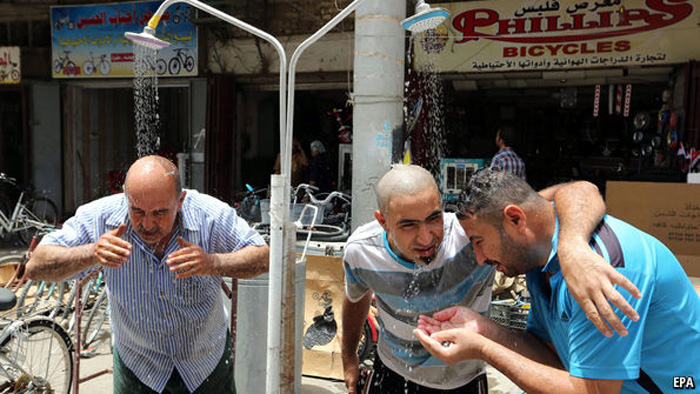“UNTIL the 1970s, Basra’s climate was like southern Europe’s,” recalls Shukri Al-Hassan, an ecology professor in the Iraqi port city. Basra, he remembers, had so many canals that Iraqis dubbed it the Venice of the Middle East. Its Shatt al-Arab river watered copious marshlands, and in the 1970s irrigated some 10m palms, whose dates were considered the world’s finest. But war, salty water seeping in from the sea because of upriver dams, and oil exploration which has pushed farmers off their land have taken their toll. Most of the wetlands and orchards are now desert. Iraq now averages a sand- or dust-storm once every three days. And this month Basra’s temperature reached 53.9ºC, a record beaten only by Kuwait and California’s Death Valley (and the latter figure is disputed). “Analysis of data suggests that since the 1970s the frequency of heat extremes has increased, while cool summer days and nights have decreased,” says Gemma Shepherd, who works for the UN’s Early Warning and Assessment Environment Programme in Nairobi.
Unlike other parts of the world where climate change has led to milder winters, in the Middle East it has intensified summer extremes, repeated studies show. Even on the Middle East’s cooler western edge, temperatures in Morocco reached 47°C. Daytime highs, notes an academic study published in the Netherlands in April, could rise by 7ºC by the end of the century. Another UN study predicted Iraq’s sandstorms would increase from 120 to 300 per year. The region also has fewer coping mechanisms than before. Population increase has exhausted water supply, leaving two-thirds of the countries in the Arabian Peninsula and the “fertile crescent” without the minimum viable for human survival, according to UN figures. Sana’a, the capital of Yemen, is set to run out of water in 2019 or perhaps earlier. In Taiz, 160 (260km) miles to the south, the water table has already collapsed. Some people have air-conditioners, but power cuts—of up 16 hours a day in southern Iraq—make them useless. Baghdadis blister their fingers on door-knobs.
They are the lucky ones. The Middle East is home to the world’s largest proportion (39%) of refugees. Hundreds of thousands live in tent cities. “If the wind blows from the north, it brings the gas from Qurna field,” says a librarian in a village north of Basra. “If it blows from the south, it’s heavy with gas from Majnoun.”
Environmental degradation is not just making life uncomfortable. The UN’s Environmental Agency (UNEA) released a report in May calculating that the harsh climate claims 230,000 lives annually in West Asia (the Arabian Peninsula and the fertile crescent), making it a greater killer than war. By somewhere between 2070 and 2100, predicts Dr Elfatih Eltahir, professor of climate at Massachusetts Institute of Technology, the temperature in much of the Gulf could have reached levels beyond which any exposure for more than six hours would be intolerable even for the fittest of humans. Current highs might seem like a normal summer day. Mecca’s outdoor pilgrimage could become hazardous. “We’re seeing just the tip of the iceberg,” he adds. “Extreme temperatures will be much worse in the future.”
In many ways, the region has made things worse than they need be. Over-irrigation has dried up lakes and turned seas into dustbowls. The Dead Sea is shrinking by a metre a year. Oil has made much of the Gulf fantastically wealthy. But like a modern-day Midas touch, its by-products threaten to choke it. Rising sea-levels could sink up to 11% of Bahrain by the end of the century, according to climate-change projections. War and urbanisation have combined to chase the rural population from the land. As desertification accelerates, sandstorms lift radioactive war detritus into the air. And war prevents implementation of counter-measures like tree planting. The bulk of the dustclouds come from the Sahara desert, but “because the eastern edges are in conflict zones, you can’t get to the land to intervene with remedies,” says Jacquie McGlade, chief scientist with the UN’s Environment Programme.
Richer states can pay to insulate themselves with artificial environments. In Kuwait, which recorded highs 0.1°C above Basra’s this week, malls turn the air-conditioning so low that wags joke they offer one of the coolest summers on earth. Land reclamation might outpace land loss from rising sea-levels. And each summer millions holiday in cooler countries.
As the costs rise so, too, does the awareness. In his blueprint for transforming his country by 2030, Saudi Arabia’s deputy crown prince, Muhammad bin Salman, aims to generate 9.5 gigawatts of renewable energy. The Arab League is gamely launching an inter-governmental committee to examine climate change. Even Syria’s jihadists are joining in. In a recent video, Jabhat al-Nusra, until this week an al-Qaeda affiliate, lauded the benefits of solar panels. Still, the world would be a better place if that organisation lacked power of any kind.







Comments